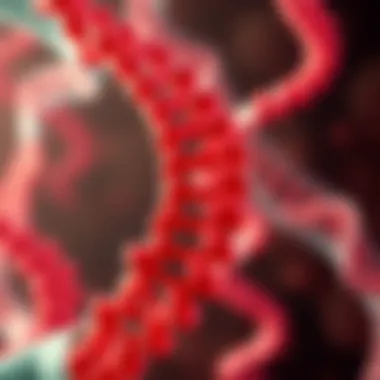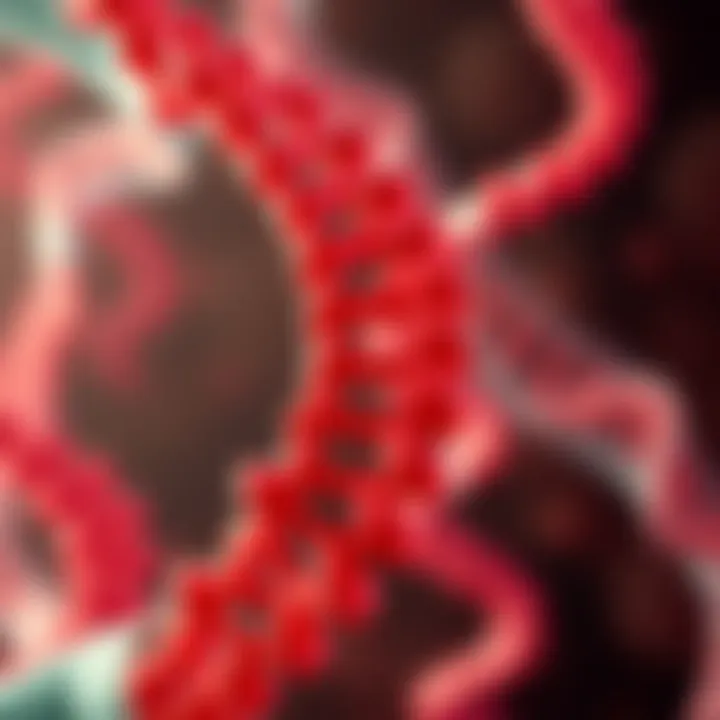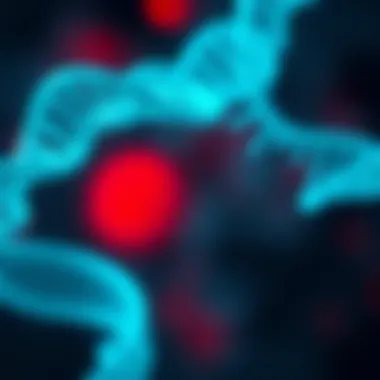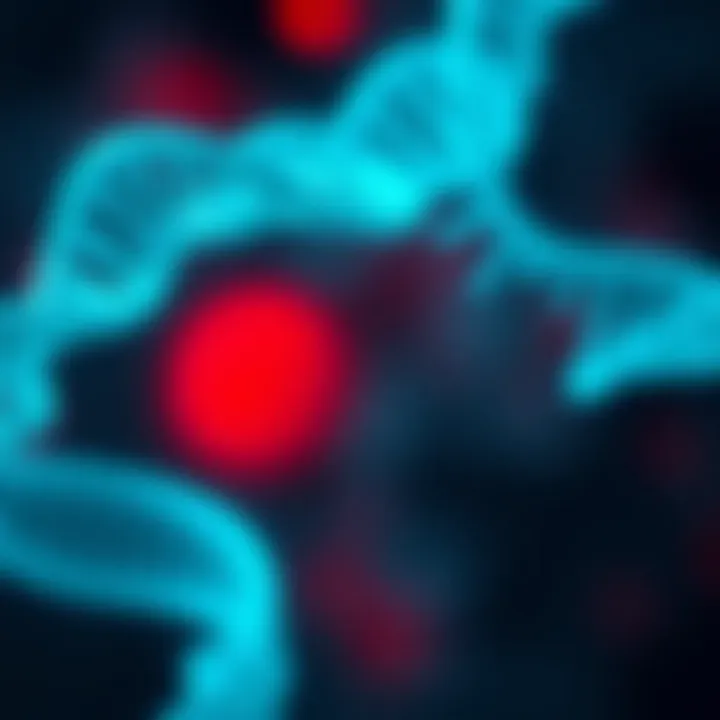Understanding the Genetic Basis of Sickle Cell Disease


Intro
Sickle cell disease (SCD) stands as a significant marker in the landscape of genetic disorders, drawing attention from scientists, medical professionals, and families alike. The disease arises from peculiar mutations in the hemoglobin gene, which ultimately alters the shape and function of red blood cells. With a simple twist in a single nucleotide, hemoglobin morphs from its usual floppy configuration to a rigid, sickle-like form. This seemingly minor change leads to a cascade of clinical repercussions, making the understanding of SCD not only essential for medical practitioners but also captivating for researchers in genetics.
In recent years, the burden of sickle cell disease has extended beyond individual affliction to become a community-wide concern. As we dive deeper into the hereditary nature of SCD, it is crucial to recognize how these genetic mutations are passed through generations, the influence on individuals and families, and the implications for public health. The article’s objective effectively taps into not only the science behind the disease but also the lived experiences, offering a holistic view.
Diads of families grappling with SCD understand that this condition doesn’t just affect the person struggling with it; it reverberates through their kin, touching lives in myriad ways. From financial burdens to emotional distress, the effects of SCD are multifaceted and complex. This exploration aims to articulate these complexities while shedding light on diagnostic methods and therapeutic advances in managing the disease.
This introduction sets the stage for a more extensive look into the world of sickle cell disease, guiding the readers through a labyrinth of genetics, inheritance patterns, clinical challenges, and treatment options that are evolving in response to ongoing research. Readers are intended to walk away with an enriched understanding of the disease’s hereditary aspects, ensuring they appreciate not only the biological underpinnings but also the potential pathways of management and support.
Prologue to Sickle Cell Disease
Sickle cell disease (SCD) stands as not just a medical concern but as a profound subject intertwining genetics, anthropology, and public health. Understanding this condition is pivotal because it underscores the intricate bond between heredity and health. Over the years, sickle cell disease has transitioned from a relatively obscure condition to a major point of discussion in both clinical settings and academic spheres.
The importance of dissecting the hereditary nature of SCD lies in its far-reaching implications. Not only does this association inform treatment approaches, but it also enhances the comprehension of disease propagation within families and populations. Knowledge about SCD plays a vital role in genetic counseling, which can help prospective parents understand their risks when planning a family.
Furthermore, this article aims to unravel the fabric of sickle cell disease, examining not only its biological underpinnings but also the social and ethical ramifications it entails. As health professionals and researchers deepen their insights into SCD, their findings can enable communities to take practical steps toward prevention and management.
Through this exploration, we set the stage for a detailed understanding of sickle cell disease, moving from the basic genetic components to the broader societal impact. Armed with knowledge about this hereditary condition, stakeholders can make informed decisions on prevention, screening, and therapeutic strategies, thus enhancing the quality of life for those affected.
Definition and Overview
Sickle cell disease refers to a cluster of disorders that affect hemoglobin, a protein in red blood cells responsible for transporting oxygen throughout the body. In individuals with SCD, the structure of hemoglobin is altered due to mutations in the HBB gene, leading to the production of abnormal hemoglobin known as hemoglobin S (HbS).
Normal red blood cells are usually round and flexible, allowing them to pass easily through blood vessels. In contrast, hemoglobin S causes red blood cells to become rigid and sickle-shaped, particularly under low-oxygen conditions. These sickled cells can obstruct blood flow in small vessels, resulting in pain crises, increased infections, and complications over time.
Historical Context
The history of sickle cell disease is rich and complex, dating back to its initial recognition in the early 20th century. The connection between sickle cell and malaria resistance began to surface in the 1920s when researchers noted that individuals with sickle cell traits exhibited greater resistance to malaria, particularly in regions where the disease was endemic.
A historical perspective illuminates the broader sociocultural influences on the perception of sickle cell disease. In many populations, especially those of African descent, SCD is often viewed through the lens of a genetic legacy, affecting healthcare decisions and attitudes toward medical research. Over the decades, advocacy efforts have aimed to raise awareness and address the stigma associated with the disease, emphasizing the need for both effective management and compassionate care.
In sum, the historical timeline of sickle cell disease not only highlights its genetic roots but also reflects the social dimensions that have shaped the current understanding and treatment of this complex disorder.
Genetics of Sickle Cell Disease
Understanding the genetics of sickle cell disease is crucial for unraveling the intricate tapestry of how this inherited disorder manifests, affects individuals, and ripples through families. At the core, sickle cell disease stems from mutations that encode for abnormal forms of hemoglobin. Grasping these genetic underpinnings not only helps in making accurate diagnoses but also in developing targeted therapies and genetic counseling strategies. With an estimated 300,000 newborns diagnosed annually worldwide, knowing the genetic elements is vital to effectively manage and potentially reduce the burden of this disorder.
Understanding Normal Hemoglobin
To grasp the implications of sickle cell disease, one first needs to understand normal hemoglobin – the protein responsible for transporting oxygen in red blood cells. Normal hemoglobin is composed of two alpha and two beta globin chains, forming a stable tetrameric structure. When oxygen binds, hemoglobin transitions to a relaxed state, allowing efficient transport to tissues. The importance of this lies in the fact that any deviations in the structure can disrupt this delicate balance. Normal hemoglobin (HbA) exhibits a round shape, allowing red blood cells to move freely through blood vessels.
However, in individuals with sickle cell disease, the defect occurs primarily due to a substitution of a single amino acid in the beta chain of hemoglobin. This mutation alters the hemoglobin's properties, turning it into hemoglobin S (HbS), which tends to polymerize under low oxygen conditions, leading to the sickling of red blood cells.
The Mutation in the HBB Gene
The genetic basis of sickle cell disease primarily revolves around mutations in the HBB gene, located on chromosome 11. This gene provides instructions for producing the beta subunit of hemoglobin. A specific point mutation causes an adenine (A) to be replaced by thymine (T), altering the amino acid sequence from glutamic acid to valine.
"This single nucleotide change can alter the destiny of an individual’s health, leading to complications such as vaso-occlusive crises, infections, and organ damage."
This mutation is a classic example of how a minor glitch at the molecular level can develop into a significant health issue. HBB is inherited in an autosomal recessive manner. This means both parents must carry at least one mutated gene for their child to be at risk of developing the disease. Knowing this mutation helps health professionals predict the likelihood of sickle cell disease in offspring, paving the way for early interventions.
Heterozygous vs Homozygous Traits
In the context of sickle cell disease, understanding heterozygous and homozygous traits is essential for assessing risk and implications for patients. When a person carries one sickle cell mutation and one normal hemoglobin gene (heterozygous), they typically do not exhibit symptoms of sickle cell disease but are considered carriers; this condition is often referred to as sickle cell trait.
In comparison, an individual who inherits two copies of the mutated gene (homozygous) is likely to develop the disease. Therefore, the distinction is pivotal. In the case of homozygous individuals, various complications such as anemia, chronic pain, and organ dysfunction can manifest due to the sickled shape of red blood cells, which causes blockages and inflammation.
Key Comparisons:
- Heterozygous (HbAS, Sickle Cell Trait):
- Homozygous (HbSS, Sickle Cell Disease):
- Carries one mutant gene, not usually symptomatic.
- May provide some protection against malaria, a historical advantage in certain regions.
- Carries two mutant genes, typically symptomatic with various health issues.
- Requires ongoing management and potential interventions.


Understanding these genetic elements sets the stage for further discussions on inheritance patterns, carrier screening, and the broader implications of sickle cell disease in various populations. The interplay of genetics and environmental factors frames the path forward in research and management.
Inheritance Patterns of Sickle Cell Disease
Understanding the inheritance patterns of sickle cell disease (SCD) is crucial for various parties—patients, families, healthcare providers, and researchers alike. This aspect affords insights into how the condition can manifest in individuals, guiding early diagnosis, management, and genetic counseling. As the saying goes, knowledge is power. Indeed, comprehending these patterns not only contributes to individual health but also aids in community awareness and public health strategies. The nuances of genetic inheritance can often seem daunting but unraveling them fosters a better approach toward prevention and treatment.
Autosomal Recessive Inheritance
Sickle cell disease follows an autosomal recessive inheritance pattern. This means an individual must inherit two copies of the mutant gene—one from each parent—to express the condition. If a person carries only one copy of the gene, they are considered a carrier (also known as being heterozygous) but typically do not show symptoms.
To illustrate, consider a family where both parents are carriers of the sickle cell trait. Each parent has a 1 in 4 chance of having a child with sickle cell disease. This distribution underscores the importance of understanding genetics in family planning. To simplify:
- 25% chance the child will inherit both normal genes (neither sickle cell nor carrier)
- 50% chance the child will inherit one normal and one sickle cell gene (carrier)
- 25% chance the child will inherit two sickle cell genes (sickle cell disease)
The reality of these probabilities highlights the need for awareness and genetic education in communities where the disease is prevalent. Understanding this foundational inheritance is a stepping stone for families navigating the complexities of SCD.
Punnett Squares and Risk Assessment
One effective tool to visualize inheritance is the Punnett square, a simple grid that helps predict the likelihood of an offspring inheriting specific traits. By mapping out the genetic contributions from each parent, it allows individuals to assess potential risks of their children inheriting sickle cell disease.
For instance, in a scenario where both parents are carriers, a Punnett square clearly illustrates the 25%-50%-25% chances of their children inheriting the gene variants. This visual representation can be reassuring for families as it demystifies the traditional probability assessments, making the statistical outcomes more palpable. Furthermore, it can encourage discussions about health and planning with regard to potential genetic implications. Resources like genetics.home.com often delve into detailed explanations and examples of these squares for further clarity.
Carrier Screening and Genetic Counseling
In the realm of managing sickle cell disease, carrier screening and genetic counseling serve as pivotal components. Carrier screening allows individuals, especially those with a family history of SCD or who belong to high-risk populations, to ascertain their carrier status. Early identification is beneficial, aiding in informed family planning decisions.
Genetic counseling complements screening by providing tailored information about the implications of being a carrier. Counselors can explain the risks not just to the individual but also to their offspring. Such discussions often include:
- The chance of having affected children
- Options for prenatal testing
- Emotional and social implications of being a carrier
This supportive framework can empower families with knowledge and enable them to make informed choices. By actively engaging in carrier screening and seeking genetic counseling, individuals promote a proactive approach to health management, potentially reducing the burden of sickle cell disease in future generations.
Clinical Manifestations of Sickle Cell Disease
Understanding the clinical manifestations of sickle cell disease (SCD) is crucial for both diagnosis and management. The symptoms and complications that arise from this condition can significantly impact the quality of life for affected individuals and their families. Knowing these manifestations helps healthcare providers deliver more effective care and allows patients to advocate for themselves better.
Common Symptoms and Complications
The clinical picture of sickle cell disease is marked by a range of symptoms that can vary in severity and frequency. These include:
- Vaso-occlusive crises: Pain episodes are a hallmark of SCD. These crises occur when sickle-shaped red blood cells block blood flow in small vessels, leading to severe pain commonly in the bones and joints.
- Anemia: The destruction of sickle cells, which have a shorter lifespan than normal red blood cells, can lead to chronic anemia. Symptoms may include fatigue, pallor, and shortness of breath.
- Acute chest syndrome: This is a potentially life-threatening complication resulting from blockage of blood vessels in the lungs. Symptoms include chest pain, difficulty breathing, and fever.
- Infections: Individuals with sickle cell disease are susceptible to infections due to spleen dysfunction. Pneumonia and other infections can occur with alarming frequency.
- Delayed growth: Children with SCD may experience growth delays and puberty can be delayed as their bodies work harder to produce healthy red blood cells.
- Stroke: Blockages in blood flow can also lead to strokes, which require immediate medical attention.
- Organ damage: Long-term complications often include damage to organs such as the spleen, liver, and kidneys due to the cumulative effect of repeated vaso-occlusive episodes.
Recognizing these symptoms is essential for prompt treatment. Patients experiencing severe pain should seek medical attention to mitigate complications, and preventative measures, such as vaccinations, are crucial in reducing the risk of infections.
Differential Diagnosis
Differential diagnosis for sickle cell disease is essential as many of its symptoms overlap with other medical conditions. Proper identification leads to optimal care. Conditions that can mimic SCD or appear alongside it include:
- Thalassemia: Similar symptoms of anemia and splenomegaly.
- Autoimmune disorders: Conditions such as lupus can also present with fatigue and pain.
- Acute respiratory infections: These can mimic acute chest syndrome, especially in children.
- Hereditary spherocytosis: This condition can also explain some of the symptomatic issues related to hemolytic anemia and splenic dysfunction.
Healthcare professionals often perform comprehensive blood tests, physical examinations, and family histories to distinguish SCD from these related conditions. A specific focus on a patient’s family background can also provide important clues, considering the hereditary nature of sickle cell disease.
"Understanding the nuances of sickle cell disease manifestations allows healthcare providers to deliver tailored and timely interventions, which can ultimately save lives."
For Further Reading
- Sickle Cell Disease Overview - A comprehensive resource on the disease's clinical considerations and management strategies.
- Latest Treatment Advances - Information on emerging treatments and research developments.
- Center for Disease Control and Prevention (CDC) - Offers statistics, educational materials, and resources for patients and caregivers.
Diagnosis of Sickle Cell Disease
The diagnosis of sickle cell disease plays a crucial role in the overall management and understanding of this genetic condition. Recognizing the disease early enhances the ability of healthcare professionals to implement timely interventions, significantly improving patient outcomes. Proper diagnosis also helps in counseling families and individuals about the risks of transmission and the potential complications associated with the disease. Collectively, these considerations make the diagnostic process a vital pillar in managing sickle cell disease.
Blood Tests and Imaging Techniques
Blood tests are the cornerstone of diagnosing sickle cell disease. One of the most common tests performed is the hemoglobin electrophoresis test. This test segregates different types of hemoglobin found in the blood, specifically looking for the presence of hemoglobin S, which is the abnormal hemoglobin responsible for sickle cell disease. Besides that, a complete blood count (CBC) can reveal an anemia characteristic in patients with sickle cell disease.


Imaging techniques, although not typically used for initial diagnosis, can also play a significant part in ongoing treatment and complication management. For instance:
- Ultrasound Doppler: This method is commonly used to assess blood flow and identify areas that may be at risk for stroke.
- MRI scans: Can help evaluate blood vessel abnormalities or brain changes symptomatic of complications from sickle cell disease.
These technologies combine to provide a full picture of the individual's health status, aiding in creating a personalized treatment plan.
Confirmation of Diagnosis
Once initial blood tests indicate the possibility of sickle cell disease, a confirmation process is essential. This often involves repeat testing and sometimes genetic studies. Parents of children with suspected sickle cell disease might be screened as well to determine carrier status, especially if there's a family history.
A definitive diagnosis not only relies on laboratory results but also considers clinical presentation. Symptoms such as pain crises or acute chest syndrome might corroborate lab findings. This integrated approach to diagnosis ensures that healthcare providers assess both the genetic factors and the phenotypical manifestations of the disease, thereby guaranteeing that patients receive the most accurate and effective care.
The importance of timely and accurate diagnosis cannot be overstated; it lays the groundwork for all subsequent management strategies, including tailored treatments and patient education.
The complexity and implications of sickle cell disease highlight the necessity for comprehensive diagnosis strategies. Whether through blood tests, imaging, or genetic studies, the goal should always be to enhance understanding and improve quality of life for individuals affected by this condition.
Management and Treatment Strategies
Managing sickle cell disease (SCD) requires a multifaceted approach that focuses not just on addressing the symptoms, but also on improving the quality of life for those affected. Effective management strategies are vital because they help prevent complications, reduce the frequency of painful crises, and support overall health. This section delves into various methodologies used in treating sickle cell disease, examining both pharmacological and non-pharmacological options.
Pharmacological Approaches
Pharmacological treatments play a cornerstone role in the management of sickle cell disease. Medications are tailored to mitigate pain episodes, prevent complications, and manage acute crises. Here’s an overview of some significant pharmacological strategies:
- Hydroxyurea: This medication has shown promise by increasing fetal hemoglobin levels. Higher fetal hemoglobin can reduce sickling of red blood cells, leading to fewer pain crises.
- Pain Management: Patients often experience episodes of severe pain. Analgesics, ranging from over-the-counter medication like ibuprofen to stronger opioids, can be necessary during these painful episodes.
- Antibiotics: Preventative antibiotics, especially in young children, are crucial to stave off infections due to functional asplenia – a common result of SCD that increases susceptibility to infections.
- Blood Transfusions: Regular transfusions can help manage symptoms and improve organ function by decreasing the sickled cells in circulation, though they come with risks, including iron overload.
In conjunction with these approaches, ongoing monitoring is critical to adjust dosages and address any adverse effects that may arise.
Non-Pharmacological Interventions
In addition to medications, non-pharmacological therapies can support those living with sickle cell disease. These strategies are designed to enhance physical health and psychological well-being by incorporating lifestyle changes and holistic treatments:
- Hydration: Drinking plenty of fluids can help decrease blood viscosity, thereby lowering the risk of crises.
- Regular Exercise: Moderate physical activity can improve overall fitness, but it's essential to avoid over-exertion, which can trigger a sickle cell crisis.
- Nutrition: A well-balanced diet rich in vitamins and minerals supports the immune system and overall health. Particularly, foods high in folate could help with red blood cell production.
- Therapeutic Counseling: Psychological support can be beneficial for anxiety and depression, which often accompany chronic conditions like SCD. Support groups provide a platform for sharing experiences and coping strategies.
Adopting these strategies contributes positively to the management plan and can significantly enhance the life of individuals dealing with SCD.
Recent Advances in Gene Therapy
Recent developments in gene therapy show tremendous potential for altering the course of sickle cell disease by targeting its root cause. Researchers are actively working on several innovative approaches to correct the genetic mutation responsible for SCD:
- CRISPR-Cas9: This groundbreaking gene-editing technology allows precise modifications to the HBB gene responsible for hemoglobin production. Clinical trials are in progress to assess its effectiveness and safety.
- Gene Addition Therapies: These involve inserting a copy of a normal HBB gene into a patient’s cells. Early results from trials indicate encouraging outcomes in increasing fetal hemoglobin production and reducing symptoms.
- Patient-derived Stem Cells: Using stem cells from a patient’s own body opens up possibilities for personalized medicine. Early-stage studies are observing the impact of such stem cell treatments on long-term health in sickle cell disease patients.
The trajectory of these advancements holds promise for a future where sickle cell disease may transition from a chronic condition to a manageable one, potentially eradicating the disorder altogether.
Advances in gene therapy signify hope for patients battling sickle cell disease, by addressing the genetic mutation head-on rather than just managing symptoms.
Epidemiology and Population Genetics
Understanding the epidemiology and population genetics of sickle cell disease is crucial for several reasons. First, it helps identify how widespread SCD is across different geographic regions and demographics. This knowledge not only sheds light on how populations are affected but also informs public health strategies aimed at prevention, diagnosis, and treatment tailored to specific communities. Additionally, insights into population genetics can reveal how environments and lifestyle factors influence genetic traits associated with the disease, furthering our understanding of health disparities related to sickle cell disease.
Global Prevalence of Sickle Cell Disease
Sickle cell disease is not a mere footnote in the narrative of human health; it’s a global concern. The World Health Organization (WHO) estimates that millions are affected worldwide, predominantly in Africa, India, and the Middle East. To really put it in perspective, in places like Sub-Saharan Africa, up to 25% of the population may carry the sickle cell trait. Moreover, these figures hint at a larger public health crisis, with severe impacts on the quality of life and economic stability for families stricken by the disease. Understanding where SCD is prevalent allows health organizations to better allocate resources, spread awareness, and develop community-specific educational programs.
"Sickle cell disease is a significant public health issue in many parts of the world, necessitating targeted educational efforts and healthcare strategies."
The prevalence extends beyond the continents. In North America, while sickle cell disease affects a smaller percentage, it remains a critical issue in African American communities, accounting for a significant health burden. The genetic marker for this disease isn't just a statistical anomaly; it represents deep historical narratives of survival against malaria in certain populations. As sickle cell disease continues to manifest in diverse populations, global efforts are essential to address both the genetic and the social dimensions of this medical condition.
Genetic Adaptations in Endemic Regions
In regions where sickle cell disease is endemic, interesting genetic adaptations have occurred, which often reflect a complex interplay of survival and evolutionary processes. One might say that genetics tells a story — the story of resilience and adaptation, born out of necessity. In malaria-prone areas, carriers of the sickle cell trait have a biological advantage. This unique trait gives them a higher chance of surviving severe malaria, which is lethal to those without it. Hence, the paradox occurs: having one sickle cell gene can protect against a deadly disease, while having two can lead to SCD.
This has created a natural selection scenario that shapes the genetic landscape of populations. Consequently, regions like West Africa, where the malaria parasite thrived, hold a higher frequency of sickle cell traits compared to populations where malaria is rare. This difference in prevalence not only indicates genetic survival strategies but also highlights the need for tailored health education and policy initiatives.
In these endemic areas, community-based approaches are crucial to address the implications of living with the sickle cell trait as well as SCD itself.


By understanding the nuances of genetic adaptations and their historical context, healthcare providers can develop smarter interventions and policies that are culturally sensitive and scientifically sound. This dual focus on genetics and epidemiology creates a foundation for effective action against sickle cell disease.
By exploring the genetic and population dynamics, we not only map the spread of sickle cell disease but also layer in the rich narrative of human resilience, adaptation, and the quest for survival.
Ethical Considerations
In recent years, the discourse surrounding sickle cell disease has expanded considerably, extending beyond the confines of genetics and medicine into the realm of ethics. This section highlights the importance of ethical considerations in dealing with sickle cell disease and its multifaceted implications for individuals and families affected by the condition.
One of the most pressing ethical concerns is genetic discrimination. Individuals with sickle cell disease or those identified as carriers may face biases in employment, insurance, and even social settings. Such discrimination often stems from a lack of understanding about the disorder itself. It can manifest subtly, through unfounded assumptions about a person's capabilities, or more overtly through policies that restrict access to certain opportunities based on an individual's genetic makeup. These issues serve as a reminder of the societal responsibility to educate and combat misconceptions about genetic disorders.
"Genetic discrimination not only impacts individuals, but it reverberates through families and communities, creating barriers that exacerbate existing inequalities."
Addressing stigmatization is equally critical. Many individuals with sickle cell disease experience feelings of isolation due to societal perceptions. There’s often a tendency to view the disease through a lens of tragedy rather than understanding it as a manageable condition with varying degrees of severity. By fostering open conversations, and providing platforms for affected individuals to share their experiences, we can reduce stigma.
Genetic Discrimination and Stigmatization
Genetic discrimination presents a complex challenge within the context of sickle cell disease. Although laws like the Genetic Information Nondiscrimination Act (GINA) in the United States aim to protect individuals from discrimination based on genetic information, gaps still exist. For instance, many organizations might not be aware of these protections, leaving individuals vulnerable to biases.
The implications of such discrimination can be severe. Those affected might face denial of health insurance coverage or difficulty securing jobs, fundamentally altering their life trajectory. Discrimination also takes an emotional toll, leading to anxiety or depression for those grappling with the dual weight of their health condition and societal rejection. Fostering awareness around these issues is paramount.
Informed Consent in Testing
Informed consent is a cornerstone of ethical medical practice, particularly in genetic testing. For individuals at risk of carrying the sickle cell trait or disease, understanding the implications of testing is crucial. Informed consent means that patients are not only aware of the technical aspect of the test but also comprehend the potential outcomes and their significance.
When counseling families about genetic testing for sickle cell disease, healthcare providers must ensure that patients fully grasp what it means to test positive, as well as the potential risks to family planning. This dialogue should include discussions about the implications of being a carrier, the emotional burden it may carry, and the possible need for ongoing medical care. Clear and empathetic communication fosters trust and assures patients they can make decisions based on comprehensive information.
Future Directions in Sickle Cell Research
The quest for better understanding sickle cell disease (SCD) continues to evolve. Research efforts focus not only on the complexities of the disease but also on innovative treatment options that could transform the lives of patients. In this article, we illuminate why diving into future directions is crucial. It’s about tackling the enduring challenges while harnessing emerging technologies. Here, we spotlight the benefits of ongoing research, particularly in the realms of treatment paradigms and gene editing technologies.
Emerging Treatment Paradigms
When thinkers speak of emerging treatment paradigms, they delve into therapies that are breaking new ground. Traditional treatments often revolve around pain management and supportive care, but contemporary science is paving the way for more targeted strategies.
A key focus is on targeted therapies that can directly address the genetic anomalies causing the disease. Some researchers are experimenting with medications that can promote the production of fetal hemoglobin, a type of hemoglobin that doesn’t sickle. Increased levels of fetal hemoglobin can result in milder disease symptoms.
- L-Glutamine: Approved by the FDA, this oral therapy reduces complications in patients aged five and older. Scientific trials have shown promising results.
- Voxelotor: This is another exciting medication aiming to stabilize hemoglobin and prevent sickling, potentially improving patient outcomes noticeably.
- Crizanlizumab: This treatment targets a specific pathway involved in pain crises associated with SCD, further aiding in the management of symptoms.
Additionally, bone marrow transplantation, while challenging, remains a potential cure for many patients. Advances in this field are leaning toward less invasive approaches, making the procedure accessible to a broader group of individuals.
Advancements in Gene Editing Technologies
Gene editing has taken center stage in the portrayal of SCD management and potential cures. Technologies like CRISPR-Cas9 offer a breathtaking glimpse into the possibilities of modifying genes responsible for the disease. By pinpointing the mutations within the HBB gene, researchers can potentially correct the errors that lead to SCD.
Some of the most promising developments include:
- Editing stem cells: Scientists are isolating and editing patient-derived stem cells to produce healthy red blood cells before reintroducing them back into the patient, thus circumventing the root cause of the disease.
- Gene addition: This method involves adding new genes that can withstand the sickling process. By introducing functional copies, researchers strive to restore normal hemoglobin production.
In clinical trials, early results suggest that patients receiving gene therapies are demonstrating improvement in their conditions. These findings could herald a new dawn for SCD management by reducing or even eliminating symptoms entirely.
The evolution of gene editing may hold the promise to change the entire paradigm surrounding sickle cell disease, ushering in not just treatments, but potential cures.
While the hurdles are vast, the rapid pace of research in both treatment paradigms and gene technologies signifies a hopeful future. As researchers refine these strategies, the ripple effect could resonate well beyond SCD, informing treatments for other genetic disorders. This evolving narrative encapsulates the importance of continued investment in research and innovation for a brighter tomorrow.
The End
The discussion surrounding sickle cell disease is not merely an academic exercise; it holds profound implications for individuals and families affected by it. By delving into the genetic mechanisms at play, we uncover the roots of this hereditary disorder, providing a solid foundation for understanding the challenges faced by those living with sickle cell disease.
Importance of Understanding Sickle Cell Disease
Understanding the hereditary nature of sickle cell disease is imperative, as it enables informed choices in areas such as family planning and medical treatment. Here are some key reasons detailing its significance:
- Clarity in Inheritance Patterns: Recognizing the autosomal recessive nature of sickle cell disease helps individuals understand the risks of passing the gene to offspring. Knowledge of these patterns can markedly influence personal decisions regarding having children.
- Empowerment Through Knowledge: The more individuals know about the genetic factors involved, the more empowered they become to advocate for themselves and others. This empowerment fosters proactive health management strategies that lead to better outcomes.
- Enhancements in Clinical Practice: Insights derived from genetic research can shape clinical guidelines, ensuring affected individuals receive tailored interventions. As we advance toward more precise medicine, understanding genetic backgrounds helps healthcare providers deliver optimal care.
- Promoting Genetic Counseling: The recognition of carrier status and examination of family backgrounds can make a real difference. Genetic counseling is pivotal in helping individuals understand their circumstances, navigate screening options, and make informed decisions.
"Knowledge is power, especially when it comes to health decisions that can impact generations."
Summary of Key Points
The conclusion synthesizes the information presented throughout the article:
- Sickle cell disease stems from a mutation in the HBB gene, resulting in abnormal hemoglobin.
- The autosomal recessive inheritance pattern dictates the transmission of the disease through generations.
- Clinical manifestations can vary widely, pointing to the need for personalized treatment approaches.
- Ongoing research focuses on developing novel therapies, including gene editing, which holds promise for future management of the disease.
In essence, a thorough exploration of the hereditary nature of sickle cell disease provides not only valuable insights into its genetic underpinnings but also equips individuals and healthcare professionals with the necessary knowledge to combat this serious condition effectively. Every bit of understanding adds a brushstroke to the larger picture, aiding in the efforts toward awareness, prevention, and treatment.



